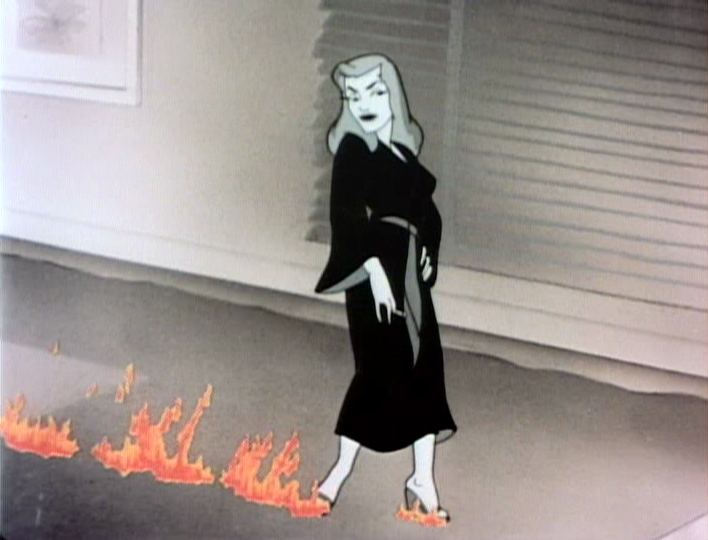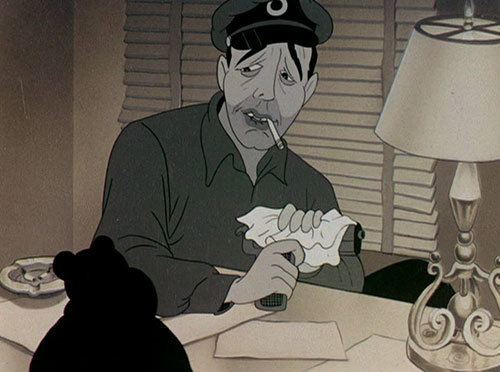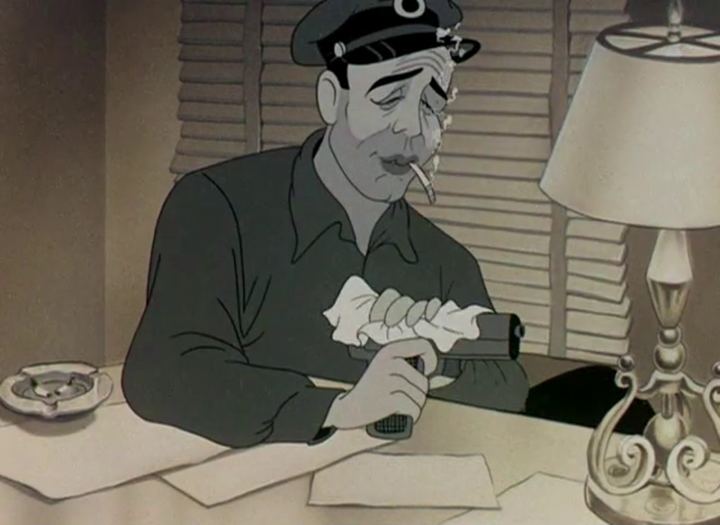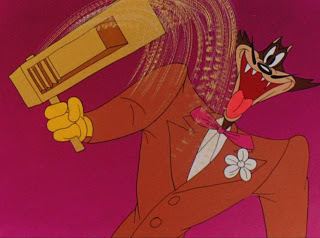Bacall to Arms
8 /10 1 Votes
Running time 7 minutes Music director Carl Stalling | Film series Merrie Melodies | |||||||||||||||||||||||||||||||||
 | ||||||||||||||||||||||||||||||||||
Director Bob Clampett (unc.)Arthur Davis (unc.) Release date August 3, 1946 (1946-08-03) (USA premiere) Directors Bob Clampett, Arthur Davis Cast Mel Blanc, Dave Barry, Robert C. Bruce, Sara Berner Similar movies Merrie Melodies movies, Related Bob Clampett movies | ||||||||||||||||||||||||||||||||||
22 jump street official movie clip undercover 2014 channing tatum jonah hill hd
Bacall to Arms is a 1946 Warner Bros. cartoon in the Merrie Melodies series, directed by Bob Clampett, in his second-to-last cartoon at Warner Bros. (The Big Snooze would be the last). Neither Clampett (he was left uncredited because he had left the studio before the cartoon was released) nor voice characterizations are credited. Mel Blanc's voice is recognizable as a fat theater patron, a husband in a newsreel, and the wolf's vocal effects. Impressionist Dave Barry portrays the voice of Humphrey Bogart while June Foray voices Lauren Bacall. The title refers both to Hemingway's A Farewell to Arms and actress Lauren Bacall, whose acclaimed film debut was in To Have and Have Not, based on another Hemingway novel, as well as a play on the term "A Call to Arms".
Contents
- 22 jump street official movie clip undercover 2014 channing tatum jonah hill hd
- Imitation of life official trailer 1 lana turner movie 1959 hd
- Background
- Plot
- Analysis
- Availability
- Bacall to arms edited extract
- References

Imitation of life official trailer 1 lana turner movie 1959 hd
Background

Bob Clampett started his directing career with black-and-white animated shorts for the Looney Tunes series, this phase of his career lasting from 1937 to 1941. In 1941, fellow director Tex Avery departed the Warner Bros. Cartoons studio. Clampett replaced Avery as the head of a unit producing films for the Merrie Melodies series, while Norman McCabe took over Clampett's former unit. The chief animator of Clampett's new unit was Robert McKimson and his style dominated their early products. Clampett reportedly found this dominance to have stifling effects on creativity, and in time trusted two other animators of the unit with more autonomy: Virgil Ross and Rod Scribner. While Clampett certainly headed a unit with notably talented animators, the distinctive styles of said animators tended to be incompatible. The use of multiple, clashing styles in a single short, gave the products of the unit a rather strange and uneven quality.

McKimson's influence eventually diminished and the animator himself left the unit in September 1944. Michael Barrier considers Bacall to Arms to be one of only 6 shorts produced by this unit to have little to no influence by McKimson, and for which the creators managed to reach a "satisfying", "unified" stylistic approach. The other five were (in chronological order) Book Revue, Baby Bottleneck, Kitty Kornered, The Great Piggy Bank Robbery, and The Big Snooze. All were released in 1946. He notes, however, that Clampett himself left the Studio at about this time. Bacall to Arms was left unfinished at the departure, and was completed under the direction of Arthur Davis.
Plot

The cartoon is set in a movie theater. Various random gags occur before the film, such as one patron moving to another seat another patron taking the vacated seat, and so on, accelerating into a free-for-all. A wolf makes a pass at a sexy movie usherette, gets slapped in the face, then settles down for the show. While the theater is in color, the films-within-the film are black-and-white. A short "newsreel" is narrated by Robert C. Bruce.

The main feature is a film called To Have- To Have- To Have- ..., a parody of To Have and Have Not. It includes images of Humphrey Bogart and Lauren Bacall, who are credited as "Bogey Gocart and Laurie Becool". In addition to recreating a few well-known scenes from that film (the kissing scene; the "put your lips together and blow" scene), the players sometimes lapse into slapstick (Bacall lighting her cigarette with a blowtorch à la Harpo Marx; or letting loose with a loud, shrill whistle after her famous sultry comment) and interact with the theater audience.
Although the theater was initially full, it is eventually seen to be empty except for one patron: a literal lone wolf in a zoot suit who goes ga-ga over Bacall. The final gag has the wolf grabbing a cigarette that was dropped in the film and jumps off the screen, and Bogie shoots him. He hands it to Bogie and it explodes, covering him with "blackface". Bogie suddenly adopts a "Eddie 'Rochester' Anderson" voice, and says, "Mah, oh mah! I can work fo' Mr. Benny nah!"
Analysis
The film reuses animation from an earlier short, She Was an Acrobat's Daughter (1937) by Friz Freleng. Like its 1930s predecessor, the film depicts a noisy movie audience member which disrupts the screening. In this case the noisy audience is represented by the wolf-whistling and howling of a wolf in the audience. The film uses caricatures of Humphrey Bogart and Lauren Bacall, who attempt to act out the scene from To Have and Have Not (1944) in which they first kiss, and her character's advice on how to whistle. Bogart eventually shoots the disruptive wolf from the movie screen, though the film within a film never properly ends. The short is one of two memorable parodies of Bogart from the Warner Bros. Cartoons studio. The other was Slick Hare (1947), where restaurant customer Bogart demands "fried rabbit" from Elmer Fudd. Setting up a plot where both Fudd and Bogart chase after Bugs Bunny.
The film functions as a tribute to Bacall and her sexual attractiveness. It was probably produced to promote the release of an upcoming feature film, The Big Sleep (1946). The film conflates two scenes from To Have and Have Not, the scene where the protagonist are introduced to each other and the whistle scene. In the original film, Bogart cleans a fishing reel. In the parody, he cleans a .45 caliber handgun. In a reference to Bacall's "hotness", when her caricature crosses the floor, she leaves a trail of flames behind her. While the film within a film is black-and-white, the flames are red and yellow. When she asks for a light, the Bogart caricature offers her a blow torch. She easily catches it and uses the torch to light her cigarette.
The distinctive voice of Eddie "Rochester" Anderson is used here to accompany a blackface-related visual gag. Christopher Lehman notes that it was typical for blackface gags in animated films to make references to well-known African American actors. References to both Anderson and Stepin Fetchit were frequently used. He notes, however, that the creators of Warner Bros. Cartoons found comedic use for Anderson's voice and ethnicity. But never for the intelligence or wit of his character, Rochester. Which he finds rather telling.
Author Don Peri points that in the 1930s, Walt Disney Productions was the industry leader in character animation. But as this studio's focus shifted from animated shorts to animated feature films, other studios started making their own advances in the field. At times depicting emotions that were absent from Disney films. Peri cites Bacall to Arms as a memorable depiction of lust in animation. The wolf himself seems similar to "Wolfie" by Tex Avery.
World War II ended in August 1945, but several animated shorts released later in that year and into 1946 still contained war-related references. In Bacall to Arms there is a newsreel featuring "wartime inventions put to peacetime use". The example depicted is that of a married man who uses a radar to receive early warnings for the unannounced visits of his mother-in-law.
Norman Klein cites the film as an example of animated films referencing film noir and figures associated with the genre, such as Bogart. He argues that screwball comedy film, the chase-themed animated films, the crime film, and film noir were genres which shared certain elements. In his view, all were reactions to the melodrama films of the 1930s and all rejected the moralizing tendecies of these melodramas. They reacted by embracing depictions of outrageous behavior and amorality. Common themes among them were the depiction of poetic justice as malum in se, of faked sentiment as a tool of deception, and sardonicism as the primary form of humor.
